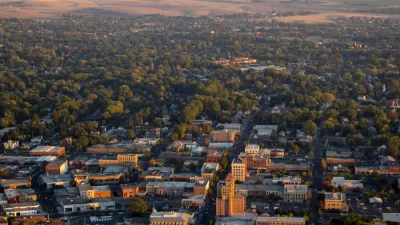Douglas County’s master plan indicates that areas south of current development will likely remain preserved through conservation initiatives, but the metro area’s booming population indicates that growth will continue to happen, somewhere.

The Denver metropolitan area has a new southern growth boundary, at least for a while, reports John Aguilar for the Denver Post. According to Aguilar, Douglas County’s master plan shows no urban development south of the town of Larkspur, “And if it ever does, it will be largely hemmed in by large swaths of land protected by conservation easements and preservation designations — the result of the purchasing power of Douglas County’s nearly 30-year-old open space sales and use tax.” In November, voters will weigh in on a 15-year extension for the tax.
However, Aguilar points out that the natural buffer created by the Douglas County plan doesn’t bar all future urban sprawl in the area, whose population has been exploding in recent years and is projected to keep growing. “The metro area as a whole, which has just over 3.2 million people now, will grow to just under 4 million in the next 18 years, according to the state demographer’s office,” more than double the 1990 population of 1.8 million. Development is booming in the north and east sides of the Denver area, limited primarily by the West’s growing water shortage and in part by the region’s geography.
FULL STORY: Metro Denver’s growing sprawl now has a hard southern boundary

Planetizen Federal Action Tracker
A weekly monitor of how Trump’s orders and actions are impacting planners and planning in America.

Maui's Vacation Rental Debate Turns Ugly
Verbal attacks, misinformation campaigns and fistfights plague a high-stakes debate to convert thousands of vacation rentals into long-term housing.

Restaurant Patios Were a Pandemic Win — Why Were They so Hard to Keep?
Social distancing requirements and changes in travel patterns prompted cities to pilot new uses for street and sidewalk space. Then it got complicated.

In California Battle of Housing vs. Environment, Housing Just Won
A new state law significantly limits the power of CEQA, an environmental review law that served as a powerful tool for blocking new development.

Boulder Eliminates Parking Minimums Citywide
Officials estimate the cost of building a single underground parking space at up to $100,000.

Orange County, Florida Adopts Largest US “Sprawl Repair” Code
The ‘Orange Code’ seeks to rectify decades of sprawl-inducing, car-oriented development.
Urban Design for Planners 1: Software Tools
This six-course series explores essential urban design concepts using open source software and equips planners with the tools they need to participate fully in the urban design process.
Planning for Universal Design
Learn the tools for implementing Universal Design in planning regulations.
Heyer Gruel & Associates PA
JM Goldson LLC
Custer County Colorado
City of Camden Redevelopment Agency
City of Astoria
Transportation Research & Education Center (TREC) at Portland State University
Jefferson Parish Government
Camden Redevelopment Agency
City of Claremont





























